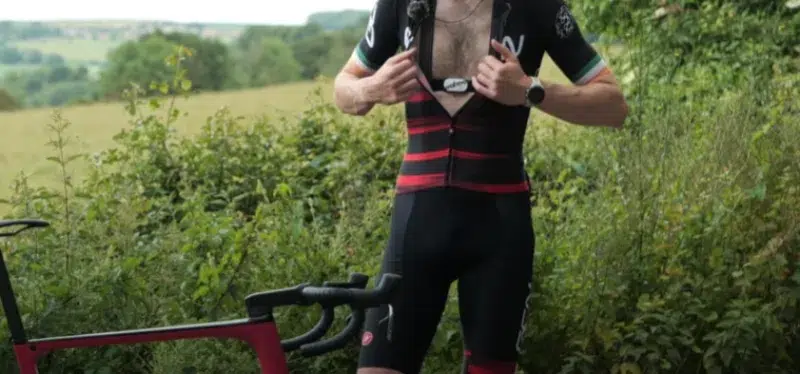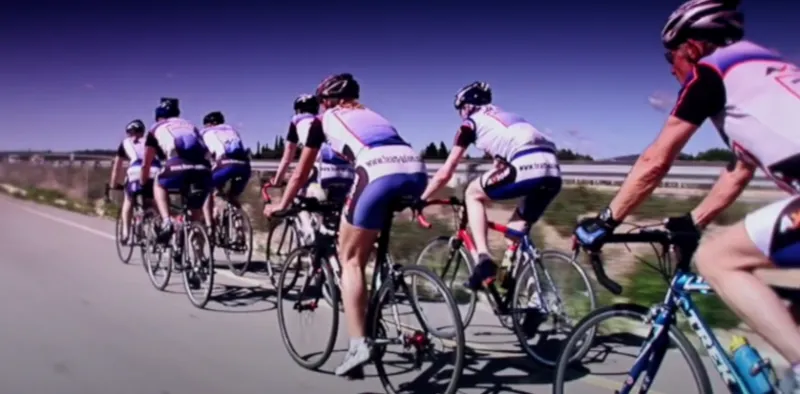You must track your heart rate to have precise insight into the intensity of your cycling sessions. Heart rate data provides valuable feedback on your cardiovascular fitness levels and progression. Cycling without monitoring your average heart rate can make tracking improvements and adjusting your training regimen challenging.
For adults between 45 and 60 years of age, an average heart rate of 80 to 150 beats per minute is good while cycling. In the 65+ age group, aim for a heart rate of 75 to 136 beats per minute.
In this informative blog post, we’ll unpick what a good average heart rate while cycling should be, considering variables such as age group and other factors affecting it. The tips and answers below will help you maintain a healthy heart rate while cycling.
What Is A Good Average Heart Rate While Cycling: 10 Factors That Affect
Regarding cycling, several variables can significantly influence your average heart rate. It is important to understand these factors in order to achieve optimal performance and training results. Here are some key factors that affect the average cycling heart rate:
Intensity of Exercise
The intensity of your cycling workout is a primary determinant of your heart rate. As you push harder and cycle faster, your heart rate naturally increases to supply more oxygenated blood to working muscles. High-intensity intervals or sprint efforts will lead to a rapid increase in heart rate compared to steady-state rides.
Training Zone
Heart rate zones, calculated according to a percentage of your maximum heart rate, dictate the intensity of your workout. Training in different zones elicits specific physiological responses and affects average heart rate differently. For instance, rides in Zone 2 (endurance) will sustain a lower heart rate than those in Zone 4 (threshold).
Fitness Level
Your cardiovascular fitness level plays a significant role in determining your average cycling heart rate. Well-trained individuals typically have lower resting heart rates and can sustain higher workloads at lower heart rates compared to untrained individuals.
Temperature and Humidity
There are several environmental factors that can affect your heart rate during cycling. In hot and humid conditions, your heart has to work harder to regulate body temperature, resulting in an elevated heart rate. Conversely, cold weather can cause vasoconstriction, increasing heart rate to maintain blood flow.
Terrain
The terrain you cycle on can significantly affect your heart rate. Climbing hills or mountains requires more muscular effort and cardiovascular output, leading to higher heart rates. Descending may allow for heart rate recovery because of reduced physical exertion.
Hydration and Nutrition
Maintaining a healthy body temperature and heart rate during cycling. Dehydration can strain the cardiovascular system, leading to an increase in heart rate. Adequate fueling with carbohydrates and electrolytes supports heart function and muscle performance.
Recuperation and sleep
The importance of adequate sleep and recovery for heart rate regulation during cycling. Poor sleep patterns and insufficient recovery time can elevate resting heart rate and impact heart rate variability, affecting overall performance.
Age and Gender
Age and gender can influence the average cycling heart rate. Resting heart rate tends to decrease with age, while maximum heart rate may decline. It turns out that women and men respond to exercise differently, with women often exhibiting slightly higher heart rates than men at comparable intensities.
Mental State
Psychological factors such as stress, motivation, and focus can affect heart rate during cycling. High-stress levels can increase heart rate, affecting performance and recovery. Positive mental states can help regulate heart rate variability and promote better overall outcomes.
Bike Fit and Equipment
Optimal bike fit and proper equipment selection are essential to riding comfortably and efficiently. Poor bike fit can lead to biomechanical inefficiencies, increasing the muscle workload and elevating heart rate.
8 Tips For Maintaining A Good Heart Rate While Cycling
Maintaining an excellent average heart rate while cycling involves proper training, monitoring, and lifestyle habits. Here are some tips to help you achieve and maintain an optimal heart rate while cycling:
Understanding Your Heart Rate Zones
Before delving into the methods to maintain good heart rates while cycling, it’s crucial to understand your heart rate zones:
- Determine Your Maximum Heart Rate (MHR): This is the most heartbeats you can have in a minute. Your MHR can be estimated using the formula 220 – your age. This provides a baseline for understanding your heart rate zones.
- Identify Your Training Zones: Different heart rate zones correspond to varying exercise intensity levels. These zones include:
- Zone 1 (50-60% MHR): Very light intensity.
- Zone 2 (60-70% MHR): Light intensity.
- Zone 3 (70-80% MHR): Moderate intensity.
- Zone 4 (80-90% MHR): Hard intensity.
- Zone 5 (90-100% MHR): Maximum effort.
Using a Heart Rate Monitor
Consider using a heart rate monitor to maintain a healthy heart rate effectively. There are two main types available:
- Chest Straps: Chest strap heart rate monitors provide reliable readings based on electrical signals generated by the heart. They offer reliable data for monitoring your heart rate throughout your cycling sessions.
- Wrist Monitors: Wrist-based heart rate monitors are convenient to wear. They use optical sensors to measure your heart rate from your wrist. While convenient, they may have limitations compared to chest straps in terms of accuracy, especially during intense workouts.
Proper Warm-Up and Cool Down Routine
Regular warm-ups and cool-downs are essential for preparing your body for exercise and aiding recovery post-workout.
- Dynamic warm-ups help your body prepare for intense activity, increase blood flow to your muscles, and loosen joints. A warm-up routine should include light cardio, dynamic stretches, and mobility exercises.
- Cool Down: After cycling, incorporate a cooldown period to lower your heart rate and prevent muscle stiffness gradually. Stretching and light aerobic activity help your body recover and reduce the risk of injury.
Incorporating Interval Training
A training interval consists of alternating short bursts of intense exercise with periods of rest or low intensity activity. This method improves cardiovascular fitness and helps regulate your heart rate.
- High-Intensity Intervals: Perform short bursts of high-intensity cycling followed by recovery periods. This method challenges your cardiovascular system, leading to improved heart rate regulation and overall endurance.
- Steady-State Rides: Incorporate longer periods of steady-state cycling at a moderate intensity. Your aerobic capacity will improve and you will enhance your ability to sustain a consistent heart rate during prolonged rides.
Monitoring Your Breathing
Proper breathing techniques are key to controlling your heart rate and optimizing performance while cycling.
- Controlled Breathing: Focus on deep, rhythmic breathing during your rides. Your nose should be closed and your mouth should be open as you are inhaling. This technique can help regulate your heart rate and oxygen intake, enhancing your cycling efficiency.
Staying Hydrated and Eating Well
Nutrition and hydration are significant in maintaining a good average heart rate during cycling.
- Hydration: Stay hydrated before, during, and after your cycling sessions. Dehydration can negatively impact your heart rate and overall performance. Carry an adequate amount of water and electrolyte-rich drinks to replenish lost fluids.
- Nutrition: Make sure your diet is balanced and includes carbohydrates, proteins, and healthy fats. Consuming complex carbohydrates before your ride can provide sustained energy levels, while post-ride protein intake aids muscle recovery and repair.
Rest and Recovery
A good rest and recovery routine cannot be overstated in any training routine, including cycling.
- Rest Days: Your training schedule should include rest days so that your body can recuperate and prevent overtraining. Adequate rest promotes muscle growth, reduces fatigue, and improves overall performance.
- Sleep: A good night’s sleep is essential to optimal athletic performance. To enhance muscle recovery, hormone balance, and recovery, get 7-9 hours of uninterrupted sleep every night.
Listening to Your Body
Listen to your body’s cues during cycling sessions. Pay attention to how you feel physically and mentally, and adjust your intensity or duration accordingly. Over time, you’ll better understand your body’s limits and capabilities.
Conclusion
As we’ve uncovered, the right average heart rate is influenced by a myriad of factors, from the intensity of your exercise, your training zone, fitness level, to even your mental state and the surrounding environment.
With the knowledge of heart rate zones and a trusty heart rate monitor at your disposal, you can optimize your cycling experience for better health and improved performance. Remember to listen to your body, adopt proper preparation and cooling down routines, and keep your hydration and nutrition in check. Your heart is more than just a beat, it’s the rhythm of your cycling journey.
FAQs
The Best Ways To Monitor Your Average Heart Rate While Cycling?
To improve and monitor various areas of your physiology, we often segment heart rate levels into zones in cycling. Heart rate can be recorded and analysed while training with a simple heart rate monitor.






